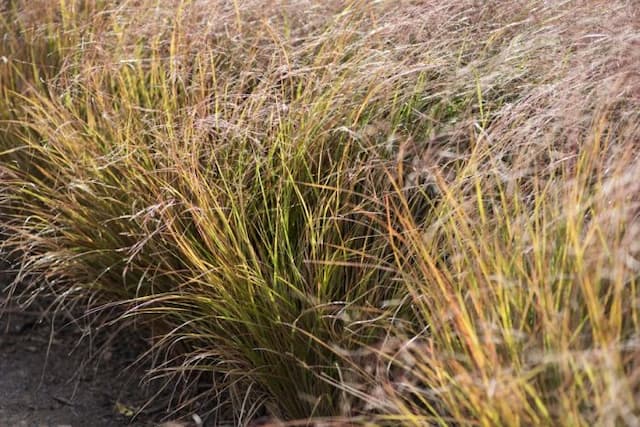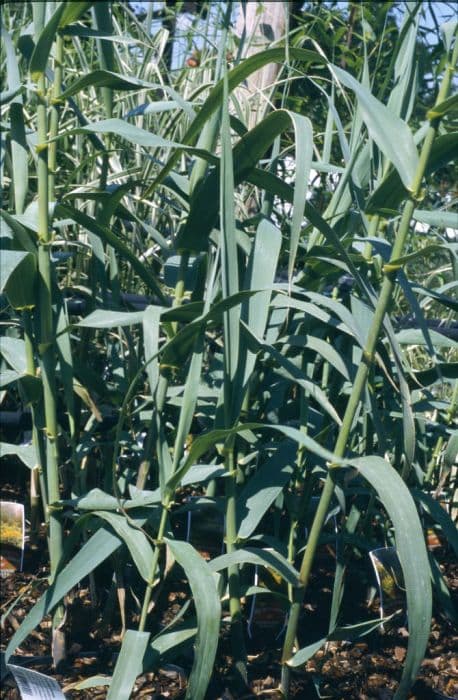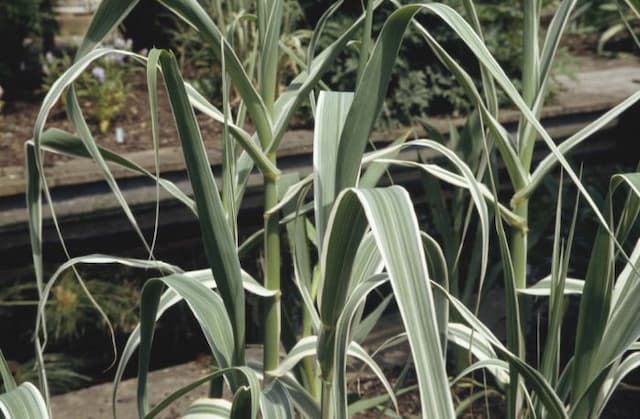African Alpine Bamboo Yushania anceps

ABOUT
Yushania anceps, commonly referred to as Ringal bamboo, is a clumping type of bamboo characterized by dense foliage and an elegant form. The plant features slender and hollow stems that are commonly known as culms; these are usually green and may have a yellowish or bluish tint. These culms are segmented with noticeable nodes, giving them a jointed appearance. Ringal bamboo displays long and narrow leaves that gracefully arch from the stems. The leaves are pointed at the tip, and their edges are smooth, showcasing a vibrant green color that may appear lighter or darker depending on the variety and growing conditions. The surface of the culms may show fine lines and textures, which contribute to the plant's overall ornamental value. The plant spreads out to form a lush thicket, creating a sense of depth and fullness. Its robust root system allows it to spread laterally, but it generally maintains a clumping habit rather than running wildly like some other bamboo species. The striking visual texture and the rustling sounds of leaves when the wind blows add to the sensory appeal of the plant. With its graceful stance and verdant foliage, Ringal bamboo serves as a popular choice for ornamental use in gardens and landscapes where its aesthetic qualities are desired.
About this plant
 Names
NamesFamily
Poaceae
Synonyms
African Alpine Bamboo
Common names
Arundinaria anceps, Thamnocalamus spathiflorus subsp. anceps, Yushania brevipaniculata.
 Toxicity
ToxicityTo humans
Yushania anceps, commonly known as African alpine bamboo, does not have a widely recognized profile for toxicity to humans. There is limited information available on any toxic compounds present in this plant and their potential effects when ingested. It is not typically considered a poisonous plant, but like with any plant material, individual allergic reactions or gastrointestinal discomfort could occur if ingested. Always exercise caution and consult with a healthcare provider if any part of the plant is ingested and symptoms or adverse reactions appear.
To pets
African alpine bamboo, the most common name for Yushania anceps, is not known to be particularly toxic to pets. There isn't much specific information on its effects on dogs, cats, or other domestic animals. As with any non-food plants, consumption might lead to mild gastrointestinal upset due to the fiber content or possible irritation to the digestive tract. If a pet ingests this plant and experiences symptoms such as vomiting, diarrhea, or unusual behavior, it is advisable to consult a veterinarian.
 Characteristics
CharacteristicsLife cycle
Perennials
Foliage type
Evergreen
Color of leaves
Green
Height
10 feet (3 meters)
Spread
6 feet (1.8 meters)
Plant type
Bamboo
Hardiness zones
8
Native area
China
Benefits
 General Benefits
General Benefits- Erosion Control: Yushania anceps, commonly known as Alpine Bamboo, has an extensive root system that helps stabilize soil and reduce erosion on slopes.
- Landscaping: Alpine Bamboo can be used to create dense privacy screens or as an ornamental feature due to its attractive foliage and growth habit.
- Habitat Creation: It provides shelter and food for a variety of wildlife, including birds and insects.
- Renewable Resource: Alpine Bamboo is a fast-growing plant, which can be harvested sustainably for various uses without harming the environment.
- Construction Material: Its strong, lightweight canes can be used to make furniture, fences, and other items.
- Culinary Uses: In some cultures, the shoots of Alpine Bamboo are edible and can be used in cooking.
- Windbreaks: The dense growth of Alpine Bamboo can serve as an effective windbreak, protecting crops and soil from wind damage.
- Cultural Significance: For many communities, this plant has cultural importance and is used in traditional practices and ceremonies.
 Medical Properties
Medical Properties- This plant is not used for medical purposes.
 Air-purifying Qualities
Air-purifying QualitiesThis plant is not specifically known for air purifying qualities.
 Other Uses
Other Uses- Yushania anceps, also known as Alpine Bamboo, can be used as a sound barrier when planted in dense clumps, due to its thick growth habit.
- The plant's dense root system can help stabilize soil on slopes and prevent erosion.
- Alpine Bamboo can be used in the construction of fences and trellises in gardens, harnessing its natural strength and flexibility.
- The mature culms of Alpine Bamboo are hollow and can be used for creating musical instruments such as flutes.
- Its long, straight poles can be employed as guiding stakes for supporting young or climbing plants in agriculture.
- Yushania anceps can be cultivated as an ornamental plant for creating garden pathways and borders due to its aesthetic appeal.
- The leaves of Alpine Bamboo can be used to thatch roofs in traditional building techniques, especially in rural areas.
- Alpine Bamboo can serve as a windbreak to shield crops and soil from strong winds when grown in agricultural lands.
- The harvested canes may be used to make rudimentary tools or simple furniture due to their durability.
- Due to its rapid growth, the plant serves as a renewable resource for crafting baskets and other woven goods.
Interesting Facts
 Feng Shui
Feng ShuiThe African alpine bamboo is not used in Feng Shui practice.
 Zodiac Sign Compitability
Zodiac Sign CompitabilityThe African alpine bamboo is not used in astrology practice.
 Plant Symbolism
Plant Symbolism- Resilience: Yushania anceps, commonly known as Alpine bamboo, is a hardy plant that can thrive in harsh conditions. It symbolizes the ability to withstand adversity and bounce back from challenges.
- Flexibility: Much like other bamboos, Alpine bamboo is flexible and bends without breaking. This flexibility represents adaptability and the importance of being open to change.
- Growth and Renewal: As a fast-growing plant, Alpine bamboo represents swift growth and the constant process of renewal. It suggests that one can grow rapidly and continuously rejuvenate oneself.
 Water
WaterThe African alpine bamboo should be watered thoroughly once the top inch of soil feels dry to the touch, which is typically about once a week, depending on environmental conditions. During hot or windy weather, it may require more frequent watering, possibly every few days, to prevent the soil from drying out completely. Ensure you provide enough water to moisten the soil all the way to the roots; this might equate to approximately 1 to 2 gallons for a mature plant in outdoor conditions, depending on the size of the bamboo and the pot or garden space. During winter or cooler months, reduce watering to every other week or less, as the plant's growth slows and it requires less moisture.
 Light
LightThe African alpine bamboo prefers bright, indirect light or partial shade to thrive. It should be placed in a location where it is protected from the harsh midday sun, which can scorch its leaves, but still receives ample morning or late afternoon light. A spot under a larger tree or beside a building that offers filtered sunlight throughout the day is ideal for this species.
 Temperature
TemperatureThe African alpine bamboo does well in a broad range of temperatures but prefers a moderate climate. It can survive minimum temperatures down to about 15 degrees Fahrenheit but is happier when the temperature stays above 50 degrees Fahrenheit. The ideal temperature range for this bamboo is between 60 and 75 degrees Fahrenheit, where it will grow most vigorously. Protection from extreme cold and frost is important for its overall health.
 Pruning
PruningPruning the African alpine bamboo is primarily done to maintain its shape and remove any dead or damaged canes, promoting healthy growth and air circulation. It should be pruned in the late winter or early spring before new growth begins. Cut back any overly tall canes to maintain a desired height and thin out the clumps by removing older, less vigorous canes. Pruning can be done annually or biennially as needed to control the size and appearance of the bamboo.
 Cleaning
CleaningAs needed
 Soil
SoilAfrican alpine bamboo prefers well-draining, loamy soil with a pH range of about 5.5 to 6.5. A good mix would be two parts garden soil, one part sand, and one part compost to ensure proper drainage and fertility.
 Repotting
RepottingAfrican alpine bamboo should be repotted every two to three years or when it becomes root-bound. Care should be taken to not damage the roots during the repotting process.
 Humidity & Misting
Humidity & MistingAfrican alpine bamboo thrives best in moderate to high humidity conditions, aiming for 40-60% ambient humidity, which reflects its native habitat conditions.
 Suitable locations
Suitable locationsIndoor
Place in bright, indirect light and maintain humidity.
Outdoor
Plant in partial shade and shelter from strong winds.
Hardiness zone
7-9 USDA
 Life cycle
Life cycleThe life cycle of the African alpine bamboo (Yushania anceps) begins with seed germination, which occurs in a suitable environment with adequate moisture and temperatures. The seedling stage follows, during which the primary shoot emerges, develops leaves, and starts photosynthesis. Next comes the vegetative stage, where the plant experiences rapid growth and the establishment of a robust rhizome system that enables the bamboo to spread clonally. Following this is the flowering stage, which for Yushania anceps is rare and sporadic, sometimes occurring at intervals of several decades. After flowering, the plant produces seeds, completing the sexual reproduction phase. Finally, many bamboo species, including possibly Yushania anceps, die after flowering and seeding in a process called monocarpic senescence, but the species perpetuates through vegetative propagation from its rhizome network.
 Propogation
PropogationPropogation time
Spring-summer
Propogation: The African alpine bamboo (Yushania anceps) is mostly propagated through division, a popular method for many bamboo species due to its effectiveness and simplicity. The ideal time for propagation is during the spring season when the plant is actively growing. To propagate by division, a healthy clump with several growing culms is carefully taken out of the ground. The root mass is then divided into smaller sections, ensuring each section has at least one or two culms with an adequate portion of roots. These divisions are immediately planted in a well-prepared soil with good drainage and kept moist until they establish. Regular watering helps the new plants to develop a strong root system, which is crucial for healthy growth.









